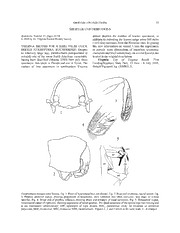
Virginia record for a rare false click beetle (Coleoptera: Eucnemidae) PDF
Preview Virginia record for a rare false click beetle (Coleoptera: Eucnemidae)
SHORTER CONTRIBUTIONS 53 SHORTER CONTRIBUTIONS Banisteria, Number 31, pages 53-54 almost doubles the number of known specimens, in © 2008 by the Virginia Natural History Society addition to extending the known range some 900 miles (1450 km) northeast from the Floridian sites. In putting VIRGINIA RECORD FOR A RARE FALSE CLICK this new information on record, I take the opportunity BEETLE (COLEOPTERA: EUCNEMIDAE).-Despite to provide some illustrations of important taxonomic its relatively large size, Dendrocharis inexspectatus is characters and brief commentary on several features not certainly one of the rarest North American eucnemids, treated in the original description. having been described (Muona, 2000) from only three Virginia: City of Virginia Beach. First specimens: two taken in Florida and one in Texas. The Landing/Seashore State Park, 23 June - 6 July 2003, capture of two specimens in southeastern Virginia Robert Vigneault leg. (VMNH 2). Dendrocharis inexspectatus Muona. Fig. 1. Front of head (mandibles not shown). Fig. 2. Head and prothorax, lateral aspect. Fig. 3. Protibia, posterior aspect, showing proportions of tarsomeres, their retraction into tibial convexity, and shape of ventral lamellae. Fig. 4. Distal end of protibia, enlarged, showing shape and armature of basal tarsomere. Fig. 5. Metasternal region, ventrolateral aspect of right side, showing appearance of tarsal grooves. The distal tarsomere of the second legs was missing and is not represented (abbreviations: EPP, epipleuron of right elytron; MSC, mesosternal cavity for reception of prosternal projection; MSF, mesofemur; MTC, metacoxa; MTS, metasternum). Figures 1, 2, and 5 drawn to the same scale, 3-4 enlarged. 54 BANISTERIA NO. 31,2008 With a robust, subcylindrical body up to 12 mm in “Abdomen without tarsal grooves” (setting off genera length, D. inexspectatus ranks among the largest of in the tribes Eucnemini and Mesogenini). In actuality, Nearctic eucnemids. That it has been captured so there are no grooves on the abdominal sterna in seldom, and not at all in intensely sampled areas like Dendrocharis, specimens of which would therefore be eastern South Carolina (Kirk, 1969), suggests that carried on to an unresolvable limbo in one of the two either the species has very low population densities, tribes mentioned. Couplet 8 could be reworded to set occupies a niche not accessed by traditional collecting off Dendrocharis by the presence of prominent deep techniques, or has an extremely short period of adult grooves in the unusually large metathoracic sterna, not activity. Maybe all three factors are operational in the present in species of Eucnemini and Mesogenini. case of this beetle. Changing the term “abdominal tarsal grooves” to Although eucnemids are considered by Muona “metathoracic sternal tarsal grooves” would correct the (2000) to be “primitive polyphagan beetles”, they share diagnostic statements for both tribe and genus on page with elaterids the thoracic modifications for projecting 59. the body upward (“the click mechanism”) and various other character systems have become highly derived in ACKNOWLEDGEMENTS some genera Dendrocharis is strikingly distinctive from all other local genera of the family in several I am very grateful to Dr. Jyrki Muona (Helsinki) respects, most of which appear to suggest a cryptic, but for identifying the species and confirming the not fossorial, life-style. The following features are inadvertent statements in his revision about the noteworthy; presence of grooves on the abdominal sterna. That this a. The eyes are small, and along with the broadly beetle can be recorded for Virginia is due to the separated antennal sockets, set low on the front of proficiency of Robert Vigneault (Oka, Ontario), the head (Fig. 1) with a deep round cavity centered in collecteur extraordinaire. the interocular space. b. The anterolateral region of the prothorax is LITERATURE CITED distinctly lobed anteriad, partly covering the eyes (Fig. 2). Kirk, V. M. 1969. A list of beetles of South Carolina. c. The dorsolateral antennal groove is “closed” Part 1 - Northern Coastal Plain. South Carolina posteriad, and remarkably deep, extending dorsad Agricultural Experiment Station Bulletin 1033. 124 pp. beneath die surface of the pronotum almost l/3rd of the distance to the middorsal lme. Muona, J. 2000. A revision of the Nearctic d. The protibiae are broadened and deeply concave Eucnemidae. Acta Zoologica Fennica 212: 1-108, figs. on the posterior face, forming a cavity into which the 1-179. protarsomeres are hinged and held out of sight (Fig. 3); the profemora also are partially concave to accommodate the flexed tibiae, the two conjointly Richard L. Hoffman fitting into a deep groove on the posterolateral edge of Virginia Museum of Natural History prothorax. 21 Starling Avenue e. The basal protarsomere is enlarged distally, with Martinsville, Virginia 24112 four distinct dentations along its ventral edge (Fig. 4), protarsomeres 2-4 are produced apically into narrow lamellae, finely pubescent on the ventral side. f. The fifth metatarsomere is as long as the basal Banisteria, Number 31, pages 54-56 four combined, relatively much longer than in other © 2008 by the Virginia Natural History Society genera. g. The metasterna are unusually long and broad, PREDATION STALEMATE: RED-TAILED HAWK each with a deep, narrow, sharp-edged groove (Fig. 5) (BUTEO JAMAICENSIS) VERSUS EASTERN which accommodates mesotarsi when the mesotibiae RAT SNAKE (PA NTHEROPHIS A LLEGHA NIENSIS). - are reflexed into a shallow groove on the rear surface of Raptor predation on snakes has been well documented the mesofemora. in the avian and herpetological literature (e.g., Guthrie, Specimens of Dendrocharis cannot be identified in 1932; Fitch et af, 1946; Knight & Erickson, 1976; the key to genera in Muona’s revision (2000: 10), Brugger, 1989; Palmer & Braswell, 1995; Greene, owing to the contrast in couplet 8 “Abdomen with 1997). Ernst (1992) and Ernst & Ernst (2003) noted 50 tarsal grooves” (leading to Dendrocharini) versus species of snakes in North America that had been killed
